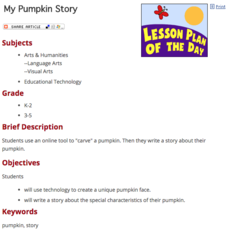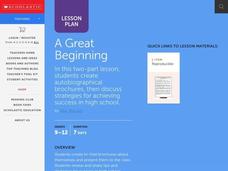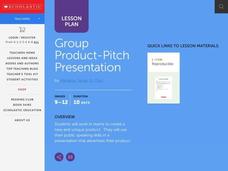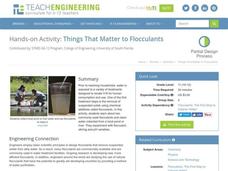Curated OER
What is Technology and How is it Used in Schools?
Students use KidPix to describe their view on technology. They share their work with others in the class. Students brainstorm ways teachers use technology with students. They differentiate between productivity and instructional tools....
Curated OER
Electronic Hydrology Lesson Plan - Revised
Students use Excel spreadsheets. They predict time and height of peak flow on river
Curated OER
Supermarket
Students watch demonstrations of 2 ways for people to check out at a supermarket based on today's technology. In this supermarket lesson plan, students conclude which method is faster and explain why.
Curated OER
Basic Computer Hardware and Software
Young scholars see pictures and learn vocabulary of basic computer hardware and software. For this computers lesson plan, students are shown pictures of a screen, mouse, keyboard, and other computer parts that they should know and fill...
Education World
My Pumpkin Story
Have young pumpkin carvers use technology to create a unique pumpkin face and write a short story about the special characteristics of their pumpkin.
Curated OER
A Great Beginning
Check out this detailed resource for some beginning of the year activities. After examining examples, class members uses the computer lab to create a personal brochure enhanced with clip art or photos to introduce themselves to the...
PHET
Learning about Space Weather
Is the sun the only celestial body with magnetic fields? A guided discussion on the weather in space is designed with a mix of questions, discussions, explanations, and applications. Additionally, the resouce includes an...
Curated OER
Blog Your Truth
Students explore communication by participating in a digital journalism activity. In this aboriginal research lesson, students view a sample blog on the Internet and identify the techniques behind blogging and Internet journalism...
Teach Engineering
Nanotechnology Grant Proposal Writing
Please, sir, can I have a few thousand dollars for my research? The last installment in a six-part lesson has the pupils develop a grant proposal. Class members apply their knowledge of skin cancer, ultraviolet radiation, human skin, and...
PHET
Earth’s Magnetic Field from Space
Feel the pull of science! The final installment of this 18-part series is an application of everything learned in the previous high school lessons. Scholars are given a magnetic field map and must propose an arrangement of magnets that...
Curated OER
Group Product-Pitch Presentation
Are you just about to teach persuasion in your class? If so, you should consider this short unit. In small groups, learners create a product, develop a magazine ad for the product, and pitch this product to the class using a visual...
Canadian Museum of Civilization Corporation
Propaganda Posters
Don't be put off by the fact that the World War I propaganda posters in this packet are Canadian and some of them are even in French. All the better, in fact, to see the techniques. The richly detailed plan has instructors model...
Institute of Electrical and Electronics Engineers
Blast Off!
With the use of a model rocket kit, aspiring aerospace engineers work cooperatively to construct and launch a rocket. A preparatory reading assignment is included, covering Newton's laws of motion and information about the first...
Classroom Law Project
What do cartoonists see in this election?
Cartoons from the 2008 Presidential election provide the text for a lesson designed to help learners understand how political cartoonists use persuasive techniques to present a point of view.
EngageNY
TASC Transition Curriculum: Workshop 15
What do a cheetah, Audi commercial, and air have in common? They're all topics of an engaging inquiry-based, hands-on workshop for educators about background knowledge, reading strategies, the CER model, and argumentative writing. The...
Scholastic
Pilgrim and Wampanoag Daily Life for Grades 6–8
Two slide shows, viewed side-by-side, permit middle schoolers to compare and contrast the lives of the Pilgrims of the Plimoth colony and the Wampanoags. Four videos take learners on virtual field trips to the Plymouth plantation. And an...
Curated OER
Be the Poet
Students work through a Haiku Organizer to determine the characteristics they use to write eight haiku poems on a theme that they choose. They design presentation folders of their completed work.
Curated OER
Where in the World is the Wide Web?
Sixth graders investigate how the web works and how to search effectively. In this Internet use lesson, 6th graders brainstorm positive and negative experiences they have had while on the Internet. Students view two web sites to learn...
Alabama Learning Exchange
Imaginary Numbers? What Do You Mean Imaginary?
Don't worry, this resource actually exists. Scholars learn about imaginary numbers and work on problems simplifying square roots of negative numbers. As an extension, they research the history of imaginary numbers.
Teach Engineering
Things That Matter to Flocculants
How does the dirt get out of your drinking water? A hands-on activity introduces the use of flocculants to help clear solid particles out of water. The plan walks learners through the process of setting up an experiment that...
Boston Public Schools
What's in a Biography?
Reinforce research skills, close reading, teamwork, and biographical writing skills with one collaborative lesson. Groups create slide shows detailing the elements of a biography through a presentation on a famous American person. Based...
SRI International
The Water Crisis
Water, water, everywhere, right? Wrong. Learners assess their own knowledge of water availability on Earth. Then, through a reading, a teacher-led presentation, and an activity, pupils learn about the importance of available clean...
EngageNY
TASC Transition Curriculum: Workshop 9
Here's a workshop for teachers that rocks the academic world! Using earthquakes as a medium for instruction, educators learn about crosscutting engineering with science. Fun, hands-on, collaborative exercises encourage participants to...
Curated OER
Mapping the Past
Middle schoolers study historical maps to view how the world evolved from medieval times through the Renaissance. They work in groups to examine the maps and present a report on one of the listed maps.

























